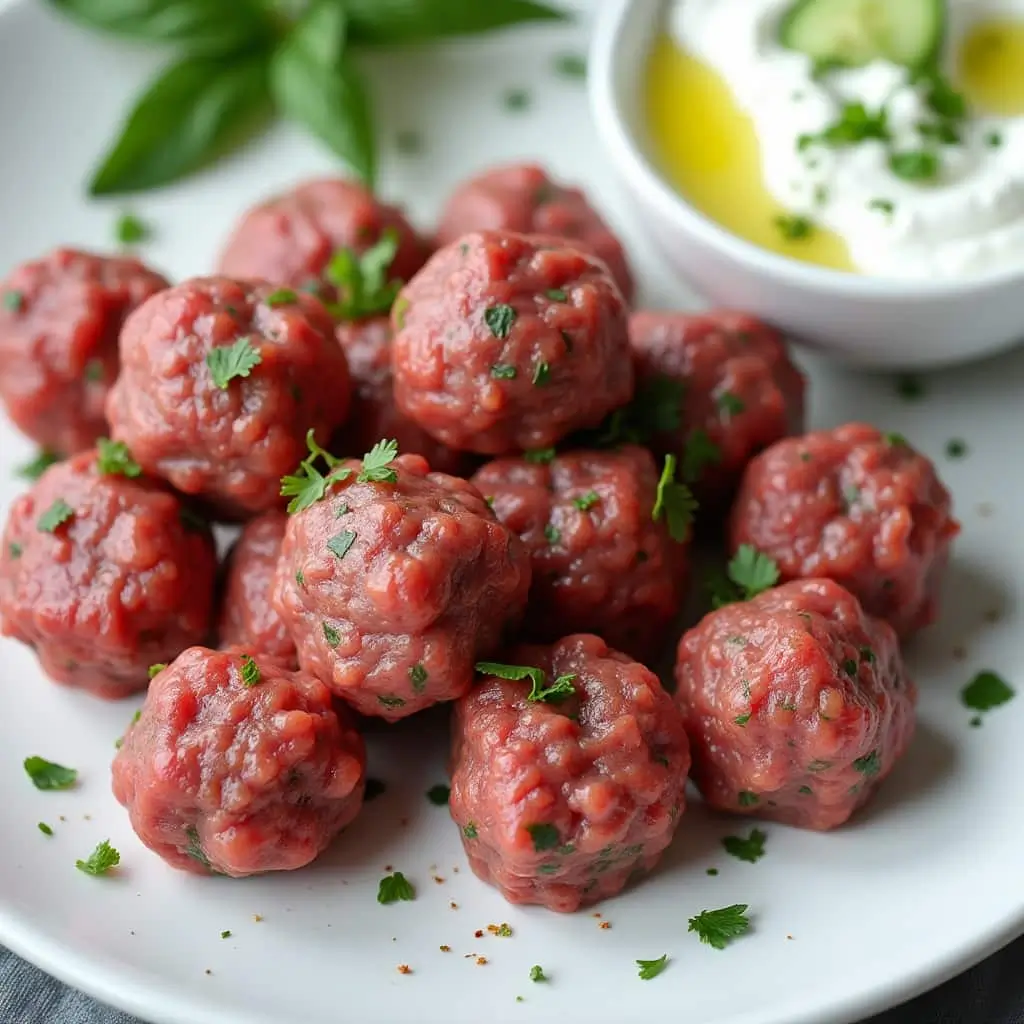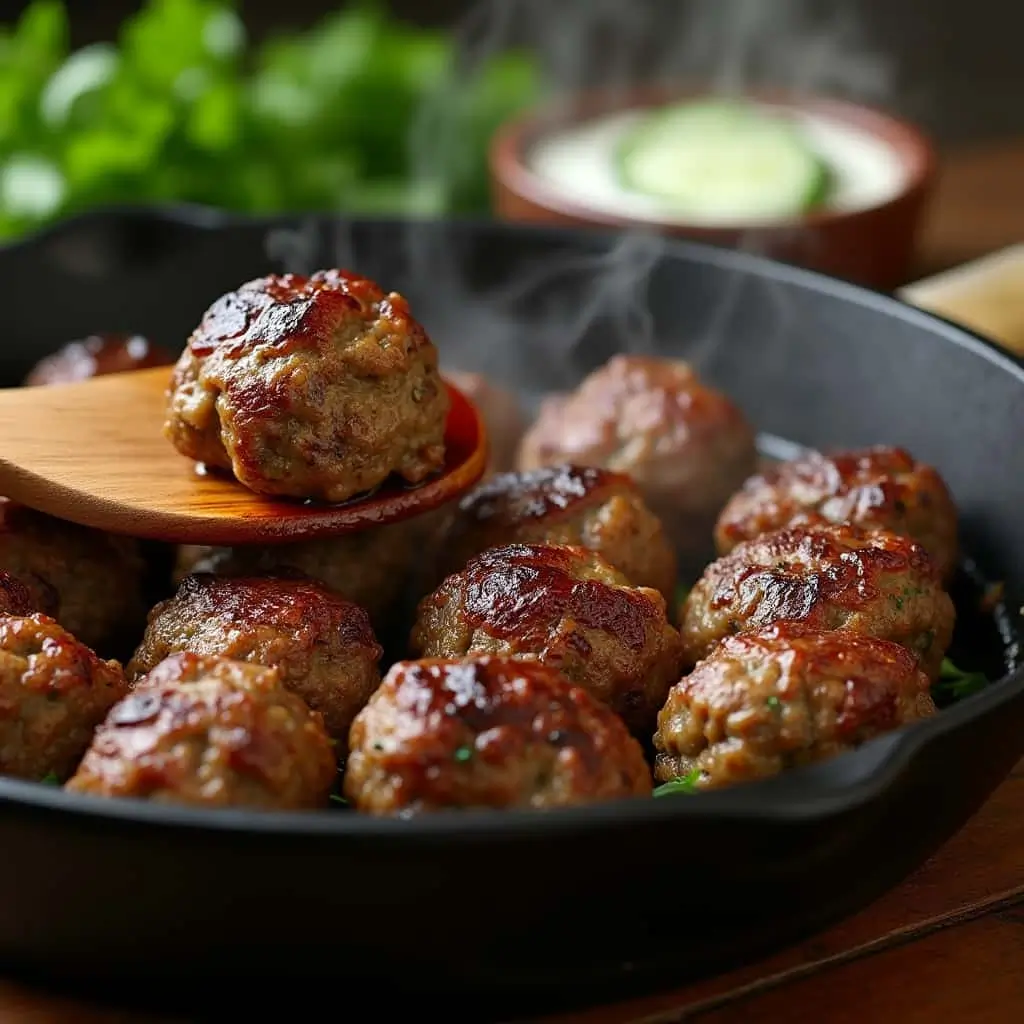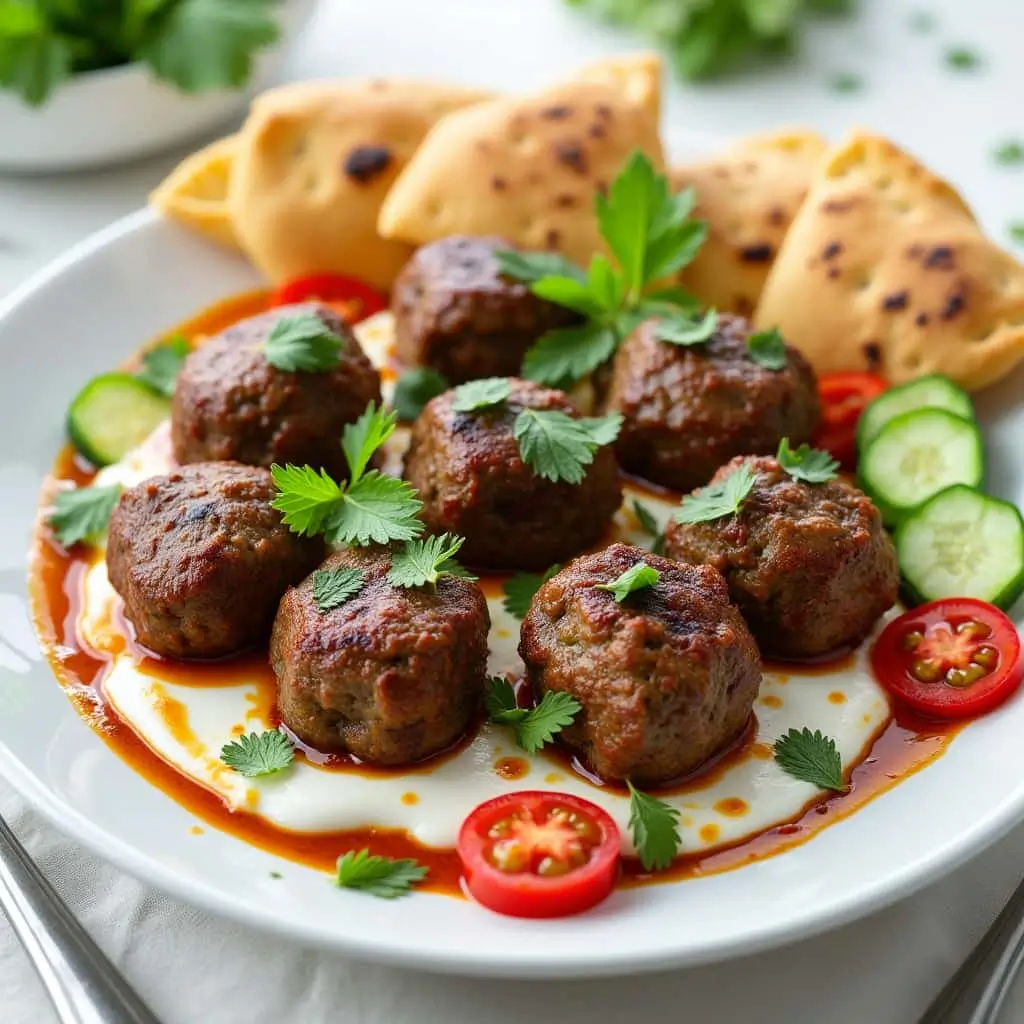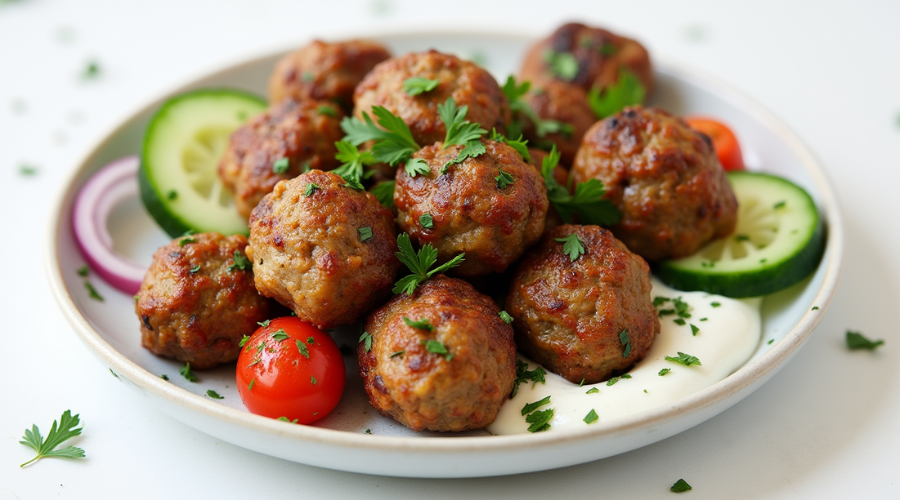Table of Contents
Introduction
Ground lamb brings a rich, distinctive flavor that elevates everyday meals into something special. While many home cooks reach for ground beef by default, ground lamb offers a flavorful alternative that’s worth exploring. With roots in Mediterranean and Middle Eastern cuisines, ground lamb recipes have been passed down through generations, creating dishes that are both hearty and full of character.
Lamb has been a staple in many cultures for thousands of years. From the mountains of Greece to the plains of Morocco, lamb features prominently in traditional cooking. Ground lamb specifically became popular as a way to use various cuts of meat efficiently, creating versatile dishes ranging from meatballs to stuffed vegetables. The Mediterranean region particularly embraces lamb for its natural flavor that pairs beautifully with bold spices and fresh herbs.
From a nutritional standpoint, ground lamb offers impressive benefits. Compared to some other ground meats, it’s packed with protein, B vitamins, zinc, and selenium. Grass-fed lamb, in particular, contains healthy omega-3 fatty acids and conjugated linoleic acid, which may have heart-healthy benefits. The rich flavor means a little goes a long way, making it both satisfying and practical for creating memorable meals.
Ingredients for Ground Lamb Recipes

Main Ingredients
For our signature Spiced Garlic Lamb Meatballs, you’ll need:
- 1 pound (454g) ground lamb
- 3 cloves garlic, minced
- 1 small onion, finely diced
- 2 tablespoons fresh parsley, chopped
- 1 tablespoon fresh mint, chopped
- 1 teaspoon ground cumin
- 1 teaspoon ground coriander
- ½ teaspoon paprika
- ¼ teaspoon ground cinnamon
- ½ teaspoon kosher salt
- ¼ teaspoon black pepper
- 1 large egg
- ¼ cup breadcrumbs
- 2 tablespoons olive oil for cooking
For the yogurt sauce:
- 1 cup Greek yogurt
- 1 small cucumber, seeded and finely diced
- 1 tablespoon fresh mint, chopped
- 1 tablespoon lemon juice
- 1 clove garlic, minced
- Salt and pepper to taste
For serving:
- Warm pita bread
- Fresh tomato slices
- Red onion, thinly sliced
- Fresh herbs for garnish
Ingredient Substitutions
Vegan Alternative: Replace ground lamb with a plant-based ground meat alternative. Enhance the flavor with extra spices, a dash of liquid smoke, and a tablespoon of olive oil to mimic lamb’s richness. Substitute the egg with 2 tablespoons of ground flaxseed mixed with 6 tablespoons of water. For the yogurt sauce, use your favorite plain dairy-free yogurt.
Gluten-Free Option: Simply substitute regular breadcrumbs with gluten-free breadcrumbs or crushed gluten-free crackers. Alternatively, cooked and cooled quinoa works well as a binder. Ensure your spices are certified gluten-free and serve with gluten-free pita or flatbread.
Other Dietary Alternatives:
- Low-carb: Skip the breadcrumbs and replace with 2 tablespoons of almond flour. Serve with lettuce wraps instead of pita.
- Dairy-free: Replace Greek yogurt with a coconut yogurt alternative, adding extra lemon juice for tanginess.
- Paleo: Use almond flour instead of breadcrumbs and serve with cauliflower flatbread instead of traditional pita.
How to Make Ground Lamb Recipes
Step 1: Preparing the Ingredients

Begin by gathering all your ingredients and ensuring they’re properly measured and prepared. This mise en place approach saves time and reduces stress during the cooking process.
For the meatballs:
- In a large bowl, place the ground lamb and allow it to come to room temperature for about 15 minutes. This helps the meat cook more evenly.
- While waiting, finely chop the onion, mince the garlic, and prepare the fresh herbs.
- Measure all dry spices and place them in a small bowl.
For the yogurt sauce:
- Seed and dice the cucumber, then place it in a clean kitchen towel and squeeze out excess moisture.
- Combine all sauce ingredients in a medium bowl, stir well, then refrigerate until serving time to allow flavors to develop.
Set out a baking sheet lined with parchment paper to hold the shaped meatballs before cooking.
Step 2: Cooking Process

Making the meatballs:
- Add the minced garlic, diced onion, fresh herbs, spices, salt, and pepper to the bowl with the ground lamb.
- Lightly beat the egg and add it to the mixture along with the breadcrumbs.
- Using clean hands, gently mix everything together until just combined. Avoid overmixing, which can make the meatballs tough.
- With damp hands, form the mixture into meatballs about 1½ inches in diameter. This should yield approximately 16-20 meatballs.
- Place the formed meatballs on the prepared baking sheet and refrigerate for 15-30 minutes to help them firm up.
Cooking the meatballs:
- Heat olive oil in a large skillet over medium-high heat until shimmering.
- Working in batches if necessary, add the meatballs to the hot skillet, being careful not to overcrowd the pan.
- Brown the meatballs on all sides, turning gently with tongs, about 2-3 minutes per side.
- Reduce heat to medium, cover the skillet, and continue cooking until the meatballs reach an internal temperature of 160°F (71°C), about 5-7 minutes more.
- Transfer cooked meatballs to a plate lined with paper towels to drain excess fat.
Step 3: Final Touches & Serving

- Warm the pita bread either in the oven, wrapped in foil at 350°F (175°C) for 5-7 minutes, or directly over a gas flame for a slightly charred effect.
- Give the yogurt sauce a final stir and place it in a serving bowl.
- Arrange the meatballs on a serving platter, drizzle with a small amount of extra virgin olive oil, and sprinkle with additional fresh herbs.
- Serve immediately with the warm pita, yogurt sauce, and fresh vegetable garnishes on the side.
For a complete meal, consider serving with a simple salad of tomatoes, cucumber, and red onion dressed with olive oil and lemon juice, or a side of couscous or quinoa to absorb the savory lamb juices.
Tips & Variations
Flavor Enhancements
Take your ground lamb recipes to the next level with these flavor boosters:
- Add a pinch of smoked paprika or Aleppo pepper to the meatball mixture for a subtle smoky heat.
- Include 2 tablespoons of crumbled feta cheese in the meatball mixture for a tangy, salty note.
- Toast and grind whole spices rather than using pre-ground versions for more intense flavor.
- Add a tablespoon of pomegranate molasses to the meat mixture for a sweet-tart depth.
- Incorporate a teaspoon of grated lemon zest into the meatball mixture to brighten the rich lamb flavor.
Texture Modifications
Achieve the perfect texture for your lamb meatballs with these adjustments:
- For juicier meatballs, add 2 tablespoons of grated onion with its juice to the mixture.
- For a lighter texture, soak the breadcrumbs in 2 tablespoons of milk before adding them to the meat.
- If you prefer a denser meatball, chill the mixture for a full hour before forming and cooking.
- For crispy exteriors, dust the formed meatballs lightly with flour before browning.
- To keep the meatballs more tender, handle the meat mixture as little as possible during mixing and forming.
Serving Suggestions
Transform your spiced lamb meatballs into different meals with these serving ideas:
- Mediterranean Bowls: Serve meatballs over couscous with roasted vegetables, hummus, and a drizzle of tahini sauce.
- Lamb Meatball Pitas: Stuff warm pita with meatballs, tzatziki, tomatoes, and thinly sliced red onions for a handheld meal.
- Lamb Meatball Soup: Add the cooked meatballs to a warm broth with chickpeas, spinach, and diced tomatoes for a hearty soup.
- Meatball Pasta: Toss the meatballs with pasta, a simple tomato sauce, and crumbled feta cheese.
- Lamb Tacos: Use the meatballs as a filling for tacos, topped with cucumber-yogurt sauce, pickled red onions, and fresh herbs.
Nutritional Information Ground Lamb Recipes
Nutritional Value Per Serving
For a serving of 4 Spiced Garlic Lamb Meatballs with 2 tablespoons of yogurt sauce (without pita):
- Calories: 320
- Protein: 24g
- Fat: 23g (Saturated Fat: 9g)
- Carbohydrates: 5g
- Fiber: 1g
- Sugars: 1g
- Sodium: 380mg
- Potassium: 385mg
- Iron: 2.5mg
- Calcium: 92mg
Learn more about Ground Lamb nutrition from the USDA.
Health Benefits
Ground lamb and its complementary ingredients offer several nutritional advantages:
Ground Lamb: Rich in high-quality protein needed for muscle maintenance and growth. Rich in vitamin B12, which plays a vital role in maintaining nerve health and aiding red blood cell production. Provides zinc, which is essential for immune function and wound healing.
Garlic: Contains compounds with antimicrobial and anti-inflammatory properties. May help lower cholesterol levels and blood pressure when consumed regularly.
Fresh Herbs: Parsley and mint add vitamin K, vitamin C, and antioxidants while providing flavor without extra calories or sodium.
Greek Yogurt: Delivers probiotics for gut health, calcium for bone strength, and additional protein. The creamy texture adds satisfaction without excessive calories.
Spices: Cumin, coriander, and other spices contain antioxidants and anti-inflammatory compounds that may provide health benefits beyond just flavor.
When compared to ground beef, lamb often contains more omega-3 fatty acids, especially when grass-fed. While it may be slightly higher in calories, many nutritionists value its nutrient density and quality fat profile.
Common Mistakes & Fixes
Issue 1: Dry, Tough Meatballs
Problem: Meatballs turn out dry and lacking juice despite following the recipe.
Causes:
- Overcooking the meatballs
- Using extremely lean ground lamb
- Overmixing the meat mixture
- Not enough moisture-adding ingredients
Solutions:
- Cook meatballs just until they reach 160°F internal temperature
- Choose ground lamb with around 15-20% fat content
- Mix ingredients until just combined
- Add a tablespoon of olive oil or 2 tablespoons of grated onion to the mixture
- Consider adding 1-2 tablespoons of yogurt to the meat mixture for extra moisture
Issue 2: Meatballs Fall Apart During Cooking
Problem: Meatballs break apart in the pan and don’t hold their shape.
Causes:
- Insufficient binding ingredients
- Not chilling the formed meatballs before cooking
- Handling the meatballs too roughly during cooking
- Turning the meatballs before they’ve developed a proper crust
Solutions:
- Add an extra tablespoon of breadcrumbs or a second egg if the mixture seems too wet
- Refrigerate shaped meatballs for 30 minutes before cooking
- Use a gentle touch when turning meatballs in the pan
- Allow meatballs to develop a brown crust on one side before attempting to turn them
- Consider baking at 400°F for 15-20 minutes instead of pan-frying for more delicate meatballs
Issue 3: Bland or One-Dimensional Flavor
Problem: The finished meatballs lack the complex, savory flavor expected from lamb.
Causes:
- Using pre-ground spices that have lost potency
- Not using enough salt
- Skipping the garlic or using too little
- Not allowing time for flavors to develop
- Cooking at too low a temperature to develop browning
Solutions:
- Replace spices that are over six months old
- Add adequate salt – generally ¾ teaspoon kosher salt per pound of meat
- Increase garlic to taste, using fresh rather than pre-minced
- Allow the mixed meat to rest for 30 minutes before forming meatballs
- Ensure your pan is properly hot before adding meatballs to develop proper browning and flavor
FAQs
1. How can I store this recipe?
Store cooked lamb meatballs in an airtight container in the refrigerator for up to 3 days or freeze for up to 3 months. Reheat gently in a covered skillet with a splash of water or in the microwave at reduced power. The yogurt sauce will keep refrigerated for 2 days.
2. What spices go well with ground lamb?
Ground lamb pairs beautifully with warm spices like cumin, coriander, and cinnamon; herbs such as mint, parsley, and rosemary; and aromatics like garlic and onion. Mediterranean and Middle Eastern spice blends including za’atar and ras el hanout also complement lamb’s rich flavor.
3. Is ground lamb healthier than ground beef?
Both meats offer excellent protein and nutrients. Lamb often contains more omega-3 fatty acids (especially when grass-fed) and slightly more iron, while beef typically has fewer calories and less saturated fat. The better option varies based on your individual dietary requirements.
4. How should ground lamb be cooked?
Cook ground lamb to an internal temperature of 160°F (71°C) for food safety. Use medium to medium-high heat to develop a flavorful brown crust. Don’t overcrowd the pan, and be careful not to overcook, which can result in dryness.
5. Is ground lamb the same as mince?
Yes, ground lamb and lamb mince refer to the same product. “Ground lamb” is the common term in North America, while “lamb mince” is typically used in the UK, Australia, and many Commonwealth countries.
6. What to make with ground lamb?
Beyond meatballs, ground lamb works well in koftas, shepherd’s pie, moussaka, lamb burgers, bolognese sauce, tacos, stuffed vegetables, and many international dishes like Indian keema, Turkish lahmacun, and Lebanese meat pies.
Conclusion & Call to Action
Ground lamb deserves a place in your cooking rotation, offering a flavorful alternative to more commonly used ground meats. The spiced garlic meatballs featured here showcase lamb’s natural affinity for aromatic herbs and bold spices, creating a dish that’s both impressive and approachable.
We encourage you to experiment with the variations suggested and make these recipes your own. Share your experiences in the comments below – your insights might inspire others to try something new!
For more Mediterranean-inspired cooking, check out our related recipes for lamb burgers with mint-feta spread, spiced lamb flatbreads, and Moroccan lamb tagine. Each builds on the techniques discussed here while offering new ways to enjoy this versatile ingredient.
Remember that cooking with lamb doesn’t have to be complicated or reserved for special occasions. With these foundational recipes, you can confidently incorporate ground lamb into your regular meal planning, creating dishes that are both nutritious and remarkably flavorful.
Related Recipes:

